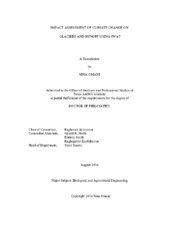| dc.description.abstract | A modified incorporated snow algorithm in Soil and Water Assessment Tool (SWAT) was applied to consider spatial variation of associated snow parameters by elevation band for flow simulation of five mountainous river basins with different climatic conditions including the Narayani (Nepal), Vakhsh (Central Asia), Rhone (Switzerland), Mendoza (Central Andes, Argentina), and Central Dry Andes (Chile) with total area of 85,000 km^(2). The results by modified snow algorithm implied slight to noticeable improvement in simulation of flow cycles and volume depend on the percentage of glacier area and climatic type of a subbasin.
The ability of model in simulation of glacier mass balance and Equilibrium Line Altitude (ELA) then was evaluated for three reference glaciers and their neighboring glacier ranges across the Europe and central Asia. The modified model successfully simulated the annual glacier loss, mass balance profile and annual ELAs with light calibration efforts and limited data. The results revealed that even very good result in monthly runoff simulation alone does not imply the consistency between simulated and measured mass balances. Calibrating the model versus flow data in combination with data of glaciers considerably reduced the model parameterization uncertainty and enhanced mass balance simulation accuracy.
To assess the range of future climate change impacts on the glacier runoff, we used maximum, minimum air temperature and precipitation projections under two RCPs (Representative Concentration Pathway) climate change scenarios and six Coupled Model Intercomparison Project-5 (CMIP5) models. Simulations of mean annual and monthly runoff, high (Q5) and low (Q95) monthly runoff and flow duration curves (FDCs) under baseline (1979–2008) and climate change scenarios are presented for all river basins. The variation of ELA related to a moderate climate change scenario then was predicted for a test study area. Therefore, the objectives of this study are:
1. Evaluating SWAT’s snow hydrologic component in glaciered basins,
2. Improvement of SWAT snow/ice melt processing,
3. Extending the applied method to macro-scale river basins,
4. Assessing the effect of future climate change on the streamflow volume and seasonal variability with focusing on glaciered areas,
5. Investigating that the global mountainous glaciers will be vanished by 2100. | en |


